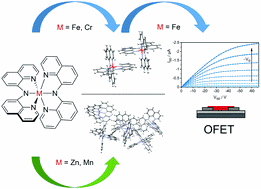New π-Stacking Motifs for Molecular Semiconducting Materials: Bis(bis(8-quinolinyl)amide)metal(II) Complexes of Cr, Mn, Fe, and Zn.
Georg Albrecht, Harald Locke, Jonathan Becker, Limei Chen, Pascal Schweitzer, Peter R. Schreiner and Derck Schlettwein
Mat. Adv. 2021, 2, 2347–2357. DOI: 10.1039/D1MA00078K.
π–π stacking of adjacent molecules is an essential prerequisite for charge carrier transport in organic semiconductors. Neutral metal–organic complexes with two pincer-type bis(8-quinolinyl)amide (BQA) ligands forming orthogonal π-systems in complexes with octahedrally coordinated metal centres (Cr, Mn, Fe, Zn) were synthesized. Cr and Fe are shown to facilitate face-to-edge and parallel displaced stacking in two orthogonal directions as evident from single crystal X-ray diffraction (XRD). We demonstrate that the crystal structure as well as properties of the electron system of these complexes can be changed substantially upon variation of the metal centre. Cyclic voltammetry, UV-Vis absorption, and DFT computations were employed to characterize electronic properties at the molecular level. Thin films of the complexes, grown as interconnected islands, were prepared and investigated by optical spectroscopy, atomic force microscopy, and electrical measurements in organic field-effect transistor geometry. Increased conductivity was measured for thin films of the Fe and Cr complexes, which showed the strongest intermolecular coupling by optimized stacking in the independently grown single crystals. Successful transfer of such beneficial stacking into the thin films is discussed based on a combination of XRD and Raman spectroscopy.

